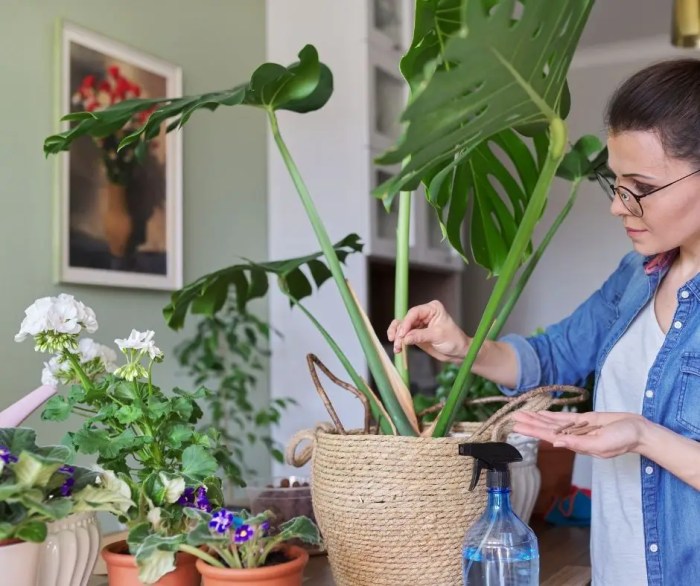How to fertilize a monstera is a question many plant parents ask, especially when they want to see their leafy companions flourish. These stunning tropical plants are known for their dramatic foliage and air-purifying qualities, but they do need a little help to reach their full potential.
Just like us, Monsteras require a balanced diet of essential nutrients to thrive.
Understanding the role of different nutrients, choosing the right fertilizer, and applying it correctly are key to keeping your Monstera happy and healthy. This guide will cover everything you need to know, from the basics of Monstera nutrition to the best fertilizer options and application techniques.
Understanding Monstera Needs

To ensure your Monstera thrives, understanding its nutritional requirements is crucial. Like any plant, Monsteras need specific nutrients for healthy growth, leaf development, and overall vitality.
Essential Nutrients for Monstera Growth
Monsteras, like all plants, rely on a range of nutrients for their well-being. These nutrients can be categorized into macronutrients and micronutrients, each playing a vital role in the plant’s development.
Macronutrients
Macronutrients are required in larger quantities than micronutrients and are the building blocks of plant growth. They include:
- Nitrogen (N):Essential for leaf growth and chlorophyll production, nitrogen contributes to the vibrant green color of Monstera leaves. It is involved in the synthesis of amino acids, which are the building blocks of proteins.
- Phosphorus (P):Phosphorus is vital for root development, flower formation, and overall plant energy production. It plays a role in cell division and energy transfer processes.
- Potassium (K):Potassium strengthens the plant’s overall structure, enhances water absorption, and contributes to disease resistance. It is involved in regulating water movement and helps maintain turgor pressure in plant cells.
Micronutrients
While needed in smaller amounts, micronutrients are equally important for Monstera health. These include:
- Calcium (Ca):Calcium plays a crucial role in cell wall formation, root growth, and disease resistance. It is essential for maintaining the integrity of plant tissues and preventing nutrient deficiencies.
- Magnesium (Mg):Magnesium is vital for chlorophyll production, contributing to the green color of leaves. It is involved in photosynthesis, the process by which plants convert sunlight into energy.
- Iron (Fe):Iron is crucial for chlorophyll production and plays a role in various enzymatic processes. It helps transport oxygen and is essential for overall plant health.
- Manganese (Mn):Manganese is involved in photosynthesis and nitrogen metabolism. It is also crucial for the activation of several enzymes essential for plant growth.
- Zinc (Zn):Zinc is involved in various enzymatic processes, including those related to growth hormones and chlorophyll production. It plays a role in regulating plant growth and development.
- Copper (Cu):Copper is essential for chlorophyll production and helps activate enzymes involved in photosynthesis and respiration. It also plays a role in plant defense mechanisms.
- Boron (B):Boron is essential for cell division and plays a role in the transport of sugars and other nutrients. It is also involved in the development of flowers and fruits.
- Molybdenum (Mo):Molybdenum is essential for nitrogen fixation and plays a role in the conversion of nitrates into usable forms for the plant. It is also involved in other metabolic processes.
Nutrient Absorption in Monstera Plants
Monstera plants absorb nutrients through their roots from the soil. The roots have tiny root hairs that increase their surface area, allowing them to efficiently absorb water and nutrients dissolved in the soil solution. This process is influenced by factors like soil composition, pH, and the availability of nutrients.
Important Note:The roots of Monstera plants are sensitive to excessive salt buildup in the soil. Overfertilization can lead to root damage and nutrient imbalances, ultimately affecting plant health.
Fertilizing a monstera is pretty straightforward, but it’s important to use a balanced fertilizer and not over-do it. While I’m on the topic of plant propagation, have you ever tried taking azalea cuttings? It’s a fun and easy way to grow new plants, and there’s a great guide on how to take azalea cuttings that I found helpful.
Anyway, back to the monstera, I usually fertilize mine every couple of months during the growing season, and that seems to work well.
Choosing the Right Fertilizer: How To Fertilize A Monstera

Just like us, Monstera plants need a balanced diet to thrive. Fertilizers provide the essential nutrients for healthy growth, but choosing the right type can be a bit confusing. Let’s explore the different types of fertilizers available and their suitability for Monstera plants.
Types of Fertilizers for Monstera
There are three main types of fertilizers you can use for your Monstera:
- Organic Fertilizers: Derived from natural sources like compost, manure, or bone meal, these fertilizers release nutrients gradually as they decompose. They improve soil structure and encourage beneficial microorganisms.
- Synthetic Fertilizers: These are chemically manufactured and contain specific nutrient ratios, making it easier to control the amount of nutrients supplied to your plant. They are readily available and often come in granular, liquid, or tablet forms.
- Slow-Release Fertilizers: These fertilizers contain nutrients encapsulated in a coating that slowly releases them over time, providing a sustained supply of nutrients. They are typically granular and are applied once or twice a year.
Advantages and Disadvantages of Different Fertilizer Types
Each type of fertilizer has its own set of advantages and disadvantages:
| Type | Advantages | Disadvantages |
|---|---|---|
| Organic | Improves soil structure, releases nutrients gradually, environmentally friendly | Can be less potent than synthetic fertilizers, may attract pests, requires more frequent application |
| Synthetic | Provides precise nutrient ratios, readily available, easy to apply | Can be harsh on soil if overused, may not be as beneficial for soil health as organic fertilizers |
| Slow-Release | Provides sustained nutrient release, less frequent application needed | May not provide immediate nutrients, can be more expensive than other types |
Nutrient Ratios and Formulations
Fertilizers are often labeled with a set of three numbers, such as 10-10-10 or 20-10-5. These numbers represent the percentage of nitrogen (N), phosphorus (P), and potassium (K) in the fertilizer.
Nitrogenpromotes healthy leaf growth and vibrant foliage. Phosphorussupports strong root development and flowering. Potassiumhelps with overall plant health, disease resistance, and water regulation.
A balanced fertilizer with a ratio close to 10-10-10 is generally suitable for Monstera plants. However, you can adjust the ratio based on your plant’s specific needs. For example, if your Monstera is experiencing slow growth, you might opt for a fertilizer with a higher nitrogen content.
Fertilizing your monstera is essential for healthy growth, but finding the right balance can be tricky. Thankfully, the world of gardening is embracing technology, and ai in gardening is making it easier to personalize care for your plants. With AI-powered apps, you can analyze your monstera’s specific needs, from soil type to light conditions, and get tailored recommendations for the perfect fertilizer and feeding schedule.
Here are some common fertilizer formulations suitable for Monstera:
| Formulation | N-P-K Ratio | Description |
|---|---|---|
| Miracle-Gro LiquaFeed All Purpose Plant Food | 24-8-16 | Provides a balanced blend of nutrients for healthy growth |
| Jobe’s Organics All Purpose Plant Food Spikes | 8-4-4 | Slow-release fertilizer with a balanced NPK ratio |
| Espoma Organic Plant Food | 5-3-3 | Organic fertilizer with a balanced NPK ratio |
Fertilizer Application Techniques

Applying fertilizer to your Monstera is a crucial step in ensuring its healthy growth and vibrant foliage. However, the timing and method of application are crucial factors in maximizing the benefits of fertilization while minimizing the risk of harming your plant.
Timing of Fertilizer Application
Fertilizing your Monstera during its active growing season, typically from spring to late summer, is essential for providing the nutrients it needs to thrive. During this period, the plant is actively producing new leaves and stems, requiring an adequate supply of nutrients.
- Spring:As the weather warms up and daylight hours increase, Monsteras begin their active growth phase. This is an ideal time to start fertilizing, providing them with the necessary nutrients for vigorous growth.
- Summer:Monsteras continue to grow rapidly during the summer months, so regular fertilization is crucial to support their ongoing development.
- Late Summer:As the days shorten and temperatures begin to cool, Monstera growth slows down. You can reduce the frequency of fertilization during this period, gradually transitioning to a less frequent application schedule.
- Fall and Winter:During the dormant period, Monsteras require minimal nutrients. Fertilizing during these months is generally not recommended as it can lead to nutrient buildup in the soil, potentially harming the plant’s roots.
Fertilizer Application Methods
The method of fertilizer application depends on the type of fertilizer you choose and your personal preference.
- Granular Fertilizer:Granular fertilizers are typically slow-release, providing a steady supply of nutrients over time. They are applied directly to the soil around the base of the plant, allowing the nutrients to be gradually absorbed by the roots. Granular fertilizers are generally easier to use and require less frequent application compared to liquid fertilizers.
- Liquid Fertilizer:Liquid fertilizers are readily available and offer a convenient way to deliver nutrients to your Monstera. They are typically mixed with water and applied to the soil through watering. Liquid fertilizers are readily absorbed by the plant’s roots, providing a quick boost of nutrients.
- Foliar Fertilizer:Foliar fertilizers are applied directly to the leaves of the plant, allowing the nutrients to be absorbed through the leaf surface. This method can be particularly beneficial for plants that are experiencing nutrient deficiencies or have difficulty absorbing nutrients through their roots.
Step-by-Step Guide to Fertilizer Application
Follow these steps to ensure safe and effective fertilizer application to your Monstera:
- Choose the right fertilizer:Select a fertilizer specifically formulated for Monstera plants or other houseplants. Look for a balanced fertilizer with a NPK ratio of 10-10-10 or similar, providing a good balance of nitrogen, phosphorus, and potassium.
- Prepare the fertilizer:If using granular fertilizer, carefully follow the instructions on the package for the appropriate amount to use. For liquid fertilizers, dilute the solution according to the manufacturer’s recommendations.
- Apply the fertilizer:For granular fertilizers, sprinkle the granules around the base of the plant, avoiding direct contact with the stem. For liquid fertilizers, water the plant thoroughly with the diluted solution, ensuring that the entire root ball is moistened. For foliar fertilizers, spray the solution evenly over the leaves, avoiding excessive wetting.
- Monitor the plant:After applying fertilizer, closely monitor your Monstera for any signs of stress or nutrient toxicity. These symptoms may include yellowing or browning of leaves, leaf drop, or stunted growth. If you observe any of these signs, immediately stop fertilizing and flush the soil with water to remove excess nutrients.
Signs of Nutrient Deficiency and Excess

Just like us, Monstera plants need a balanced diet to thrive. Recognizing signs of nutrient deficiencies and excesses can help you intervene before they cause significant harm.
Nutrient Deficiencies
Nutrient deficiencies can manifest in various ways, impacting your Monstera’s growth and appearance.
- Yellowing Leaves:A common sign of nitrogen deficiency. The leaves may also turn pale green or have yellow patches. Nitrogen is crucial for chlorophyll production, which is responsible for photosynthesis.
- Stunted Growth:If your Monstera is struggling to grow, it could be lacking phosphorus. Phosphorus plays a vital role in root development and overall plant growth.
- Brown Leaf Tips:This could indicate a potassium deficiency. Potassium helps regulate water balance and strengthens the plant’s overall health.
- Chlorosis (Yellowing Between Veins):This is a sign of iron deficiency. Iron is essential for chlorophyll production and is often absorbed less efficiently in alkaline soil conditions.
- Wilting:While wilting can be caused by various factors, a calcium deficiency can make the plant more susceptible to wilting due to its role in cell wall structure.
Consequences of Over-fertilizing
While providing essential nutrients is crucial, overdoing it can be just as detrimental. Excess fertilizer can cause various issues:
- Burned Roots:High salt concentrations from fertilizers can damage delicate root systems, leading to stunted growth and even plant death.
- Leaf Tip Browning:Excess fertilizer can disrupt the plant’s water balance, leading to brown leaf tips and edges.
- Slowed Growth:Ironically, too much fertilizer can actually hinder growth as the plant struggles to absorb nutrients effectively.
- Leaf Drop:Over-fertilizing can stress the plant, leading to leaf drop. This is a sign that the plant is struggling to cope with the excessive nutrients.
Correcting Nutrient Imbalances
Once you’ve identified a nutrient deficiency or excess, you can take steps to correct the imbalance:
- Adjust Fertilizer Application:Reduce the frequency or concentration of fertilizer applications if you suspect over-fertilization.
- Flush Soil:To remove excess salts, flush the soil with water until it drains freely from the drainage holes. This helps dilute the fertilizer concentration.
- Soil Testing:Conduct a soil test to determine the specific nutrient levels in your soil. This can provide valuable information about what nutrients are lacking or in excess.
- Targeted Nutrient Supplements:If you identify a specific deficiency, you can use targeted nutrient supplements to address it. For example, iron chelates can help correct iron deficiency.
Environmental Factors Affecting Fertilizer Needs

Monstera plants, like all living organisms, are influenced by their environment. Understanding how factors like light, temperature, and humidity affect their growth is crucial for determining the right fertilization schedule. These factors can directly influence the plant’s nutrient uptake and overall health.
Light Intensity and Fertilizer Needs
The intensity of light plays a significant role in Monstera’s nutrient requirements. Bright, indirect light encourages vigorous growth, leading to increased nutrient demand. In such conditions, Monstera plants require more frequent fertilization to support their rapid development. Conversely, plants in low light conditions have a slower growth rate, reducing their nutrient needs.
Temperature and Fertilizer Needs
Temperature affects the rate of metabolic processes in Monstera plants, influencing their nutrient absorption. Warm temperatures, typically between 70-85°F (21-29°C), promote faster growth, leading to higher nutrient demand. However, excessive heat can stress the plant, hindering nutrient uptake. Cooler temperatures, on the other hand, slow down growth, reducing the plant’s need for nutrients.
Humidity and Fertilizer Needs
Humidity plays a crucial role in Monstera’s nutrient uptake. High humidity levels create a favorable environment for root growth and nutrient absorption. In humid environments, Monstera plants generally require more frequent fertilization. Conversely, low humidity can lead to slower growth and reduced nutrient absorption, requiring less frequent fertilization.
Potting Mix and Nutrient Availability
The potting mix used for Monstera plants can significantly influence nutrient availability. Different mixes have varying levels of organic matter, which affects the soil’s ability to retain nutrients.
A well-draining potting mix with a good balance of organic matter is ideal for Monstera plants.
- Organic-rich mixesprovide a slow and steady release of nutrients, reducing the need for frequent fertilization. These mixes often contain ingredients like compost, coco coir, and peat moss.
- Inorganic mixes, like those based on perlite and vermiculite, generally require more frequent fertilization as they don’t retain nutrients as well as organic mixes.
Optimal Growing Conditions and Fertilizer Needs
The following table Artikels the optimal growing conditions for Monstera plants and their corresponding fertilizer needs:
| Growing Condition | Optimal Range | Fertilizer Needs |
|---|---|---|
| Light Intensity | Bright, indirect light | More frequent fertilization |
| Temperature | 70-85°F (21-29°C) | More frequent fertilization |
| Humidity | High humidity | More frequent fertilization |
| Potting Mix | Well-draining, organic-rich mix | Less frequent fertilization |
Organic Alternatives to Chemical Fertilizers

While chemical fertilizers can be effective, they can also have negative impacts on the environment and your Monstera’s long-term health. Organic alternatives offer a safer and more sustainable approach to providing your plant with essential nutrients.
Compost Tea for Monstera Plants
Compost tea is a nutrient-rich liquid fertilizer that can be easily made at home. It is a fantastic way to introduce beneficial microorganisms to your Monstera’s soil, promoting healthy root growth and nutrient uptake.To create a compost tea solution, you’ll need a container with an air pump and a good quality compost.
Here’s a simple recipe:
1. Fill a 5-gallon bucket with water.
- Add 1 cup of compost to the bucket.
- Aerate the mixture with an air pump for 24-48 hours.
- Strain the tea and use it to water your Monstera.
You can also add additional ingredients to your compost tea, such as molasses or fish emulsion, to further enhance its nutrient content.
Benefits of Organic Fertilizers, How to fertilize a monstera
Organic fertilizers like fish emulsion and seaweed extract offer a range of benefits for your Monstera.
- Improved Soil Health:Organic fertilizers contribute to a healthier soil structure, improving drainage and aeration.
- Nutrient Availability:They release nutrients gradually, making them readily available to your Monstera over time.
- Environmental Sustainability:Organic fertilizers are naturally derived and do not contain harmful chemicals that can pollute the environment.
- Increased Microbial Activity:They encourage the growth of beneficial microorganisms in the soil, which promote healthy root development.
Homemade Fertilizer Blends
You can easily create your own homemade fertilizer blends using kitchen scraps and natural ingredients. Here are a few recipes:
Banana Peel Tea
Banana peels are rich in potassium, a vital nutrient for Monstera growth.
1. Cut banana peels into small pieces and place them in a jar.
- Fill the jar with water and let it sit for a week.
- Strain the tea and use it to water your Monstera.
Eggshell Fertilizer
Eggshells are a good source of calcium, which helps strengthen your Monstera’s stems and leaves.
1. Crush eggshells into fine pieces.
- Mix the crushed eggshells with water and let it sit for a few days.
- Strain the mixture and use it to water your Monstera.
Coffee Grounds
Coffee grounds are rich in nitrogen, which promotes healthy leaf growth.
1. Use used coffee grounds as a top dressing around your Monstera.They can also be added to your compost pile.
Ultimate Conclusion

Fertilizing your Monstera plant is a simple yet powerful way to encourage its growth and enhance its beauty. By understanding its needs and applying the right fertilizer at the right time, you can create an environment where your Monstera can truly thrive.
Remember, a healthy Monstera is a happy Monstera, and a happy Monstera is a joy to behold!